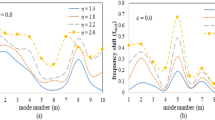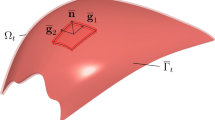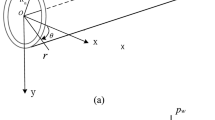Abstract
In this article, the transient response of a cylinder, with a piezoelectric coating, weakened by multiple radial cracks is investigated. The problem is under torsional transient loading. First, the solution of the problem, weakened by a Volterra-type screw dislocation, is achieved by using Laplace and the finite Fourier sine transform. The solution is obtained for displacement and stress fields in the bar with a piezoelectric layer. At the next step, the dislocation solution is used to derive a set of Cauchy singular integral equations for analysis of bars with a circular cross section containing some radial cracks. The solution of the singular integral equations is used to determine the torsional rigidity of the cross section and also the stress intensity factors of the crack tips. In addition, several examples are presented to show the effect of the piezoelectric coating and torsional transient loading on the stress intensity factors and torsional rigidity of the system.






















Similar content being viewed by others
References
Li, C., Duan, Z., Zou, Z.: Torsional impact response of a penny-shaped interface crack in bonded materials with a graded material interlayer. J. Appl. Mech. 69, 303–308 (2002)
Atsumi, A., Shindo, Y.: Torsional impact response in an infinite cylinder with a circumferential edge crack. J. Appl. Mech. 49, 531–535 (1982)
Li, C., Weng, G.J., Duan, Z.: Dynamic behavior of a cylindrical crack in a functionally graded interlayer under torsional loading. Int. J. Solids Struct. 38, 7473–7485 (2001)
Ueda, S., Shindo, Y., Atsumi, A.: Torsional impact response of a penny-shaped crack lying on a bimaterial interface. Eng. Fract. Mech. 18, 1059–1066 (1983)
Ueda, S., Shindo, Y., Atsumi, A.: Torsional impact response of a penny-shaped interface crack in a layered composite. Eng. Fract. Mech. 19, 1095–1104 (1984)
Feng, W.J., Su, R.K.L., Jiang, Z.Q.: Torsional impact response of a cylindrical interface crack between a functionally graded interlayer and a homogeneous cylinder. Compos. Struct. 68, 203–209 (2005)
Sih, G.C., Embley, G.T.: Sudden twisting of a penny-shaped crack. J. Appl. Mech. 39, 395–400 (1972)
Vafa, J., Fariborz, S.: Transient analysis of multiply interacting cracks in orthotropic layers. Eur. J. Mech. A/Solids 60, 254–276 (2016)
Ecsedi, I., Baksa, A.: Prandtl’s formulation for the Saint-Venant’s torsion of homogeneous piezoelectric beams. Int. J. Solids Struct. 47, 3076–3083 (2010)
Vafa, J.P., Baghestani, A.M., Fariborz, S.J.: Transient screw dislocation in exponentially graded FG layers. Arch. Appl. Mech. 85, 1–11 (2015)
Gao, C.F., Wang, M.Z.: General treatment of mode III interfacial crack problems in piezoelectric materials. Arch. Appl. Mech. 71, 296–306 (2001)
Hassani, A.R., Monfared, M.M.: Analysis of cracked bars with rectangular cross-section and isotropic coating layer under torsion. Int. J. Mech. Sci. 128–129, 23–36 (2017)
Bleustein, J.L.: A new surface wave in piezoelectric materials. Appl. Phys. Lett. 13, 412–413 (1968)
Kuang, Z.B.: Theory of Electroelasticity. Springer, Berlin (2013)
Pak, Y.E.: Circular inclusion problem in antiplane piezoelectricity. Int. J. Solids Struct. 29, 2403–2419 (1992)
Chue, C.H., Wei, W.B., Liu, T.J.C.: The antiplane electro-mechanical field of a piezoelectric wedge under a pair of concentrated forces and free charges. J. Chin. Inst. Eng. 26, 575–583 (2003)
Gao, C.-F., Balke, H.: Fracture analysis of circular-arc interface cracks in piezoelectric materials. Int. J. Solids Struct. 40, 3507–3522 (2003)
Chue, C.H., Liu, W.J.: Antiplane electro-mechanical field of a piezoelectric finite wedge under a pair of concentrated forces and free charges. J. Chin. Inst. Eng. 27, 841–850 (2004)
Weertman, J., Weertman, J.R.: Elementary Dislocation Theory. Macmillan, New York (1964)
Wang, Y.: Torsion of a thick-walled cylinder with an external crack: boundary collocation method. Theor. Appl. Fract. Mech. 14, 267–273 (1990)
Cohen, A.M.: Numerical Methods for Laplace Transform Inversion. Springer, New York (2007)
Faal, R.T., Fariborz, S.J., Daghyani, H.R.: Antiplane deformation of orthotropic strips with multiple defects. J. Mech. Mater. Struct. 1, 1097–1114 (2006)
Hassani, A.R., Faal, R.T.: Torsion analysis of cracked circular bars actuated by a piezoelectric coating. Smart Mater. Struct. 25, 125030 (2016)
Tao, F.M., Tang, R.J.: Saint-Venant’s torsion problem for a composite circular cylinder with aninternal edge crack. Appl. Math. Mech. Engl. Ed. 14, 507–516 (1993)
Hassani, A.R., Monfared, M.M.: Analysis of an orthotropic circular bar weakened by multiple radial cracks under torsional transient loading. Eng. Fract. Mech. 186, 300–315 (2017)
Faal, R.T., Fotuhi, A.R., Fariborz, S.J., Daghyani, H.R.: Antiplane stress analysis of an isotropic wedge with multiple cracks. Int. J. Solids Struct. 41, 4535–4550 (2004)
Acknowledgements
The authors would like to acknowledge Islamic Azad University, Karaj Branch (Iran), for financial support of this research.
Author information
Authors and Affiliations
Corresponding author
Additional information
Publisher's Note
Springer Nature remains neutral with regard to jurisdictional claims in published maps and institutional affiliations.
Appendices
Appendix A
Kernels of the integral equations are:
The left side of the integral equation (33) is
where all the parameters with index i are functions of p and those with index j are functions of q.
Appendix B
1.1 Proof of Eq. (26)
We use a formula given in the appendix of Ref. [26]
Equation (B1) can be rewritten as
With the aid of formulas between hyperbolic functions, we can achieve Eq. (26)
1.2 Proof of Eq. (27)
When \(n\rightarrow \infty \), \(N_1\) can be approximated with n. Then, we can use expansion of \({\Omega }_n\) as
By defining \(\eta =\frac{e_{15}^2 + \epsilon _{11} C_{44} -G \epsilon _{11}}{e_{15}^2 + \epsilon _{11} C_{44} +G \epsilon _{11}}\) we have
With the aid of Eq. (B5), we follow the proof of (27) as
By using Eq. (B3), Eq. (B6) is rewritten as
In the following discussion, Eq. (B7) can be expressed in terms of \(F_m ({x, \theta })\) as
1.3 Proof of the Eq. (34):
The domain of integration (33) is divided into three subregions \(r<a\), \(R_1 >r\ge a\) and \(R_2 \ge r\ge R_1\). Substituting Eqs. (3) and (14) into Eq. (33) results in
We use some relations according to the definition of the dislocation cut as
Using the above equations, the proof is completed as
Rights and permissions
About this article
Cite this article
Bagheri, R., Hassani, A.R. Crack analysis of circular bars reinforced by a piezoelectric layer under torsional transient loading. Arch Appl Mech 89, 1555–1578 (2019). https://doi.org/10.1007/s00419-019-01527-y
Received:
Accepted:
Published:
Issue Date:
DOI: https://doi.org/10.1007/s00419-019-01527-y




